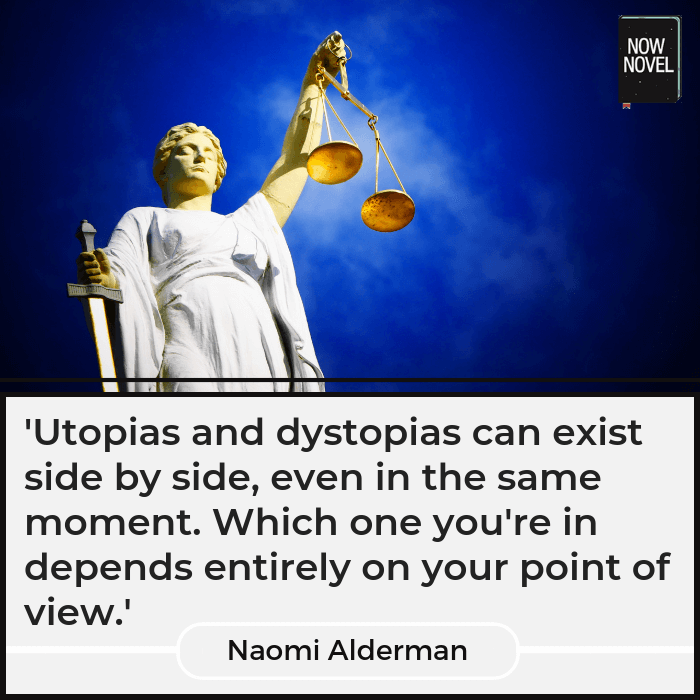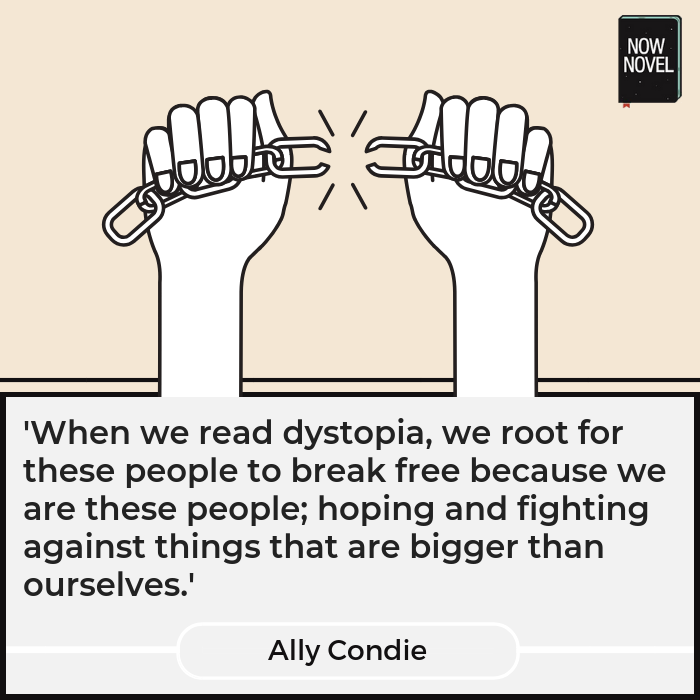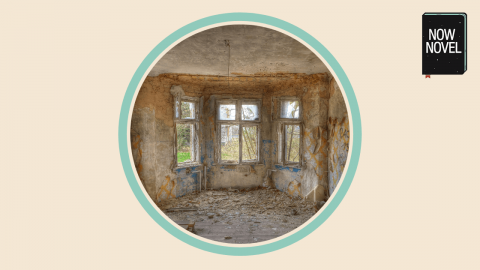Dystopian stories about characters or societies grappling with ‘bad places’ like post-apocalyptic wastelands remain popular for several reasons. For one, their situations naturally supply intense conflict, drama and suspense. How do you write a dystopian story? Start with these 5 tips:
First, what is a dystopian story?
The word ‘dystopia’ comes from the Latin prefix dys- meaning ‘bad’ and the root topos meaning ‘place’ (literally a ‘bad place’).
The word is often contrasted with utopia. Thomas More coined utopia in 1516. It was the title of his book about an imaginary island where legal, political and social systems all create social harmony. The word thus suggests ‘paradise’ and is often taken to mean a ‘good place’, even though utopia’s roots actually mean ‘no place’.
In fiction, a ‘dystopia’ is:
‘An imagined state or society in which there is great suffering or injustice, typically one that is totalitarian or post-apocalyptic.’
‘Dystopia’, Oxford Dictionaries Online
Famous dystopias in books
Famous dystopian novels include George Orwell’s Nineteen Eighty-Four (1949). In Orwell’s classic, Great Britain has become a totalitarian province and the government has outlawed ‘thought crimes’.
Another example is Margaret Atwood’s The Handmaid’s Tale (1985). In this novel, women are kept as baby-making servants with scarcely any basic rights.
How do you write a good dystopian story?
1. Start with a strong scenario
Classic dystopian novels and stories begin with a troubled scenario. For example:
- Great Britain, now named ‘Airstrip One’, has become a province of a greater territory named ‘Oceania’ ruled by the ‘Party’. The Party uses ruthless ‘Thought Police’ to persecute individualism and independent thought (Nineteen Eighty-Four)
- A radical religious group calling itself ‘The Sons of Jacob’ overthrows the United States government. It replaces it with a religious political system based on Old Testament fanaticism, removing women’s rights to read, write, own property and handle money (The Handmaid’s Tale)
We can easily see why each of these would be ‘bad places’ (or dystopian settings) for characters who value their freedoms and rights.
What makes these good dystopian scenarios?
Each of the above scenarios is strong. It presents a situation that would give any character interesting motivations, to either uphold the system or destroy (or simply survive) it.
The two dystopia examples above are both political dystopias.
Other types of dystopian scenarios include environmental ones. For example, the post-apocalyptic environment in Margaret Atwood’s Oryx and Crake (2003).
In this novel, characters struggle in the fallout caused by scientific, medical experimentation. In Cormac McCarthy’s The Road (2006), a father and son must journey and survive in a post-apocalyptic wasteland where some unnamed catastrophe has destroyed most of civilization.
These are all dramatic situations that give rise to interesting stories of hope, resistance, survival, memory and loss. They’re cautionary tales about the dangers of power or the fragility of the lives or rights we might take for granted. And sometimes they’re optimistic stories too, showing the power of the human spirit to endure the difficult and painful.

2. Create a believable dystopian world
A believable dystopian world typically presents a keen sense of threat, menace or discomfort.
Example of a fantasy dystopian world
Even though it is not a ‘dystopian novel’ in the strict sense of the word, C.S. Lewis’s beloved The Lion, the Witch and the Wardrobe (1950) from his Chronicles of Narnia series has elements of dystopian fiction.
In The Lion […], four siblings stumble upon a magic world where the ‘White Witch’, Jadis, has stopped the seasons. By magic, Jadis keeps Narnia in eternal winter. This dystopian environment affects Narnia’s talking animals who plead with the siblings to help free them from Jadis’ spell.
At the start of Lewis’ novel, Narnia is a world that used to be better, freer, easier to live in. It has become a dystopia through the abuse or misuse of power (in this case, magical power). This is a common theme in dystopian fiction.
To create a believable dystopian world:
- Know how your world got to its current state: Lewis’s shows us early in the children’s adventures in Narnia why things are in their sorry state. It’s up to you whether you reveal the origin of your dystopia early, later, or keep it as a mysterious background detail that shapes characters’ arcs.
- Describe dystopian settings well: What is a dystopian setting? It’s a ‘bad place’ of suffering and injustice, like the winter world in Narnia that disrupts animals’ life cycles. Describe these settings so we can tell clearly what makes them so uncomfortable.
- Brainstorm and imagine details: Think of details down to what characters are able to eat, wear, do. How might their altered social, natural or political environment change ordinary interactions and activities?
3. Develop your dystopian settings
Dystopian settings such as cities razed by global conflicts will naturally present characters with many challenges, from dangerous, crumbling infrastructure (environmental challenges) to social issues such as increased lawlessness, mutual mistrust and other social effects.
When developing a dystopian setting, ask questions such as:
- Who now has power now, and why?
- Who is the most vulnerable in this dystopian society and why?
- What still works and what no longer exists?
- What do people remember and what have they forgotten (e.g. names, cultural practices, people, places)?
Example of an effective dystopian setting
In David Mitchell’s era-hopping adventure novel Cloud Atlas (2004), the middle section is set in a time that could be post-apocalyptic or ‘pre-civilization’. It’s hard to tell, at first. In this section of the story titled ‘Sloosha’s Crossin’ an’ Ev’rythin’ After’, Zachry, an old man, narrates his memories of an event called ‘The Fall’ that wiped out his people’s predecessors.
Mitchell brilliantly camouflages familiar places and names using deliberate misspellings, so we gradually see pieces of Zachry’s past (the earth we know today) emerge. He writes ‘Hawaii’, for example, as ‘Ha-why’ in Zachry’s narration.
Mitchell uses shifting language to show what changes in a place after a catastrophe. We see history’s process of holding onto and forgetting in action. This creates a sense of Zachry’s world spanning a long, partially forgotten history. Some events are remembered in detail, while others fade, enter folklore.
4. Create conflicts, threats and challenges
Because a dystopia is a ‘bad place’, it follows they are usually places rich in conflict and ‘trouble’.
In ‘Sloosha’s Crossing’ in Cloud Atlas, Zachry recalls cannibal raids by rival tribes. In The Handmaid’s Tale ‘Unwomen’ are women unable to bear children, and are banished to highly polluted areas called ‘The Colonies’.
Where there is a system of injustice, unfairness, danger or oppression, there are interesting situations for characters to resist, avoid, escape or confront.
When writing a dystopian story, it’s helpful to think about best- and worst-case scenarios. These help us identify what characters want to do, and also what they want to avoid.
What’s the worst thing that could happen to your character in this dystopia? And what is the best? [Use the ‘Characters’ section of Now Novel’s story outlining tools to find characters’ individual best and worst case scenarios.]
Bringing characters into close scrapes with worst-case scenarios is good for creating tension and conflict.

5. Give characters credible motivations
In dystopian fiction, as in other types of stories, character motivations are important. There has to be a reason why the government bans free thought, or decides to meddle with women’s reproductive rights and other liberties.
A tyrant, such as the leader of the ‘Sons of Jacob’ in Atwood’s novel, may be motivated by:
- Ideology – the set of beliefs they hold (tyrants may believe, for example, that a fanatically literal interpretation of the Old Testament is the only ‘right’ way while quietly ignoring how it also gives them extreme gender or other privilege)
- Lust for power
- Greed
- Backstory such as personal trauma that has left them embittered
Whatever your characters’ reasons for upholding or demolishing your story’s dystopia, it has to make sense for the story. Ask yourself:
- What does my character gain if they choose to be complicit with the ‘bad’ aspects of this dystopia?
- What could my character gain if they attempt to fight or overcome the underlying situation?
We see these differences in how people respond to tough environments in a story with dystopian elements like The Lion, the Witch and the Wardrobe. One sibling, Edmund, is more selfish and less immune to flattery. He is thus easily charmed and manipulated by Jadis to do her bidding, betraying the others.
Get feedback on your dystopian story idea or extracts from your draft, and use Now Novel’s story outlining tools to brainstorm the many settings, characters and situations that will shape your story.


19 replies on “How do you write a dystopian story? 5 tips”
Good stuff. These tips would also apply well to other genres. Thanks for sharing.
Thanks for reading and sharing your feedback (and sharing our articles on Twitter), Elias.
good
Thanks, Mo!
This really helps with all my homework and my english
Hi Nyambura, that’s lovely to hear. Good luck with your homework.
Key thing really is concept (strength of concept) and detail. I also truly value believability – make it relatable!
“Novel: Coronavirus” wouldn’t be a bad working title, thinking about it.
PS Surprised there’s no examples from Ray Bradbury or Aldous Huxley!
Hi Josh, thank you for sharing your interesting insights on this. I agree regarding believability. I like your working title idea, the play on words. Good point re: Bradbury and Huxley, perhaps when this article gets an update there’ll be more seminal dystopia examples included. Thanks for reading and for your feedback!
Hi,
Thanks for all these tips. I need to write a dystopian novel. It will help me!
It’s a pleasure, Lila! We’re only glad to help with your writing.
First, my name is a play on words. Second, qwertyuiopasdfghjklzxcvbnm SO HELPFULLLLLLLLLLLLL!
Is it a play on ‘anonymous’? ? thank you for your feedback!
Trying to write a dystopian novel, Big help!! Ty!!! Im taking notes down now! Maybe youll see a book some day!
Hi Holly, that’s great to hear. Good luck with your book!
I am writing a short dystopian story and it has to have an idea of the greater good, some dialogues, and descriptive language.
That sounds interesting, thank you for sharing that. When you say ‘has to’, are you writing it for a school assignment? If you’d like feedback on any part of it, you can swap critiques with other members in our writing community.
It is very helpful thx.
Thanks so much for these useful tips! For a while now, I have been trying to write a dystopian book/piece. I will definitely use this tips to write it!
Hi Harry, it’s a pleasure! Good luck with your dystopian story.